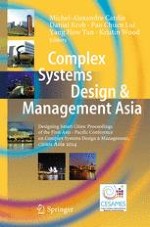This book contains all refereed papers that were accepted to the first edition of the Asia-Pacific
conference on « Complex Systems Design & Management » (CSD&M Asia 2014) that took place in
Singapore from December 10 to December 12, 2014 (Website: http://www.2014.csdm-asia.net/).
These proceedings cover the most recent trends in the emerging field of Complex Systems, both
from an academic and a professional perspective. A special focus is put on Designing Smart cities.
The CSD&M Asia 2014 conference is organized under the guidance of the Center of Excellence on
Systems Architecture, Management, Economy and Strategy, CESAMES, non-profit organization,
address: CESAMES, 8 rue de Hanovre, 75002 Paris, France ( Website : http://www.cesames.net/en).
